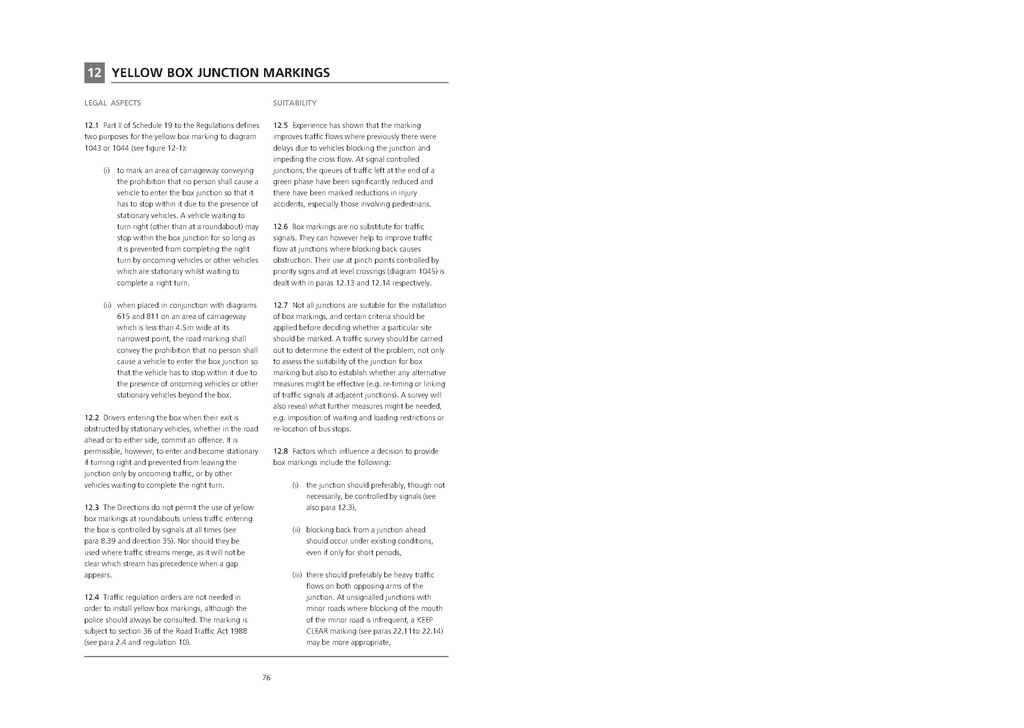12YELLOW BOX JUNCTION MARKINGS
LEGAL ASPECTS
12.1 Part II of Schedule 19 to the Regulations defines two purposes for the yellow box marking to diagram 1043 or 1044 (see figure 12-1):
(i) to mark an area of carriageway conveying the prohibition that no person shall cause a vehicle to enter the box junction so that it has to stop within it due to the presence of stationary vehicles. A vehicle waiting to turn right (other than at a roundabout) may stop within the box junction for so long as it is prevented from completing the right turn by oncoming vehicles or other vehicles which are stationary whilst waiting to complete a right turn.
(ii) when placed in conjunction with diagrams 615 and 811 on an area of carriageway which is less than 4.5 m wide at its narrowest point, the road marking shall convey the prohibition that no person shall cause a vehicle to enter the box junction so that the vehicle has to stop within it due to the presence of oncoming vehicles or other stationary vehicles beyond the box.
12.2 Drivers entering the box when their exit is obstructed by stationary vehicles, whether in the road ahead or to either side, commit an offence. It is permissible, however, to enter and become stationary if turning right and prevented from leaving the junction only by oncoming traffic, or by other vehicles waiting to complete the right turn.
12.3 The Directions do not permit the use of yellow box markings at roundabouts unless traffic entering the box is controlled by signals at all times (see para 8.39 and direction 35). Nor should they be used where traffic streams merge, as it will not be clear which stream has precedence when a gap appears.
12.4 Traffic regulation orders are not needed in order to install yellow box markings, although the police should always be consulted. The marking is subject to section 36 of the Road Traffic Act 1988 (see para 2.4 and regulation 10).
SUITABILITY
12.5 Experience has shown that the marking improves traffic flows where previously there were delays due to vehicles blocking the junction and impeding the cross flow. At signal controlled junctions, the queues of traffic left at the end of a green phase have been significantly reduced and there have been marked reductions in injury accidents, especially those involving pedestrians.
12.6 Box markings are no substitute for traffic signals. They can however help to improve trafficflow at junctions where blocking back causes obstruction. Their use at pinch points controlled by priority signs and at level crossings (diagram 1045) is dealt with in paras 12.13 and 12.14 respectively.
12.7 Not all junctions are suitable for the installation of box markings, and certain criteria should be applied before deciding whether a particular site should be marked. A traffic survey should be carried out to determine the extent of the problem, not only to assess the suitability of the junction for box marking but also to establish whether any alternative measures might be effective (e.g. re-timing or linking of traffic signals at adjacent junctions). A survey will also reveal what further measures might be needed, e.g. imposition of waiting and loading restrictions or re-location of bus stops.
12.8 Factors which influence a decision to provide box markings include the following:
(i) the junction should preferably, though not necessarily, be controlled by signals (see also para 12.3),
(ii) blocking back from a junction ahead should occur under existing conditions, even if only for short periods,
(iii) there should preferably be heavy traffic flows on both opposing arms of the junction. At unsignalled junctions with minor roads where blocking of the mouth of the minor road is infrequent, a KEEP CLEAR marking (see paras 22.11 to 22.14) may be more appropriate,
76
